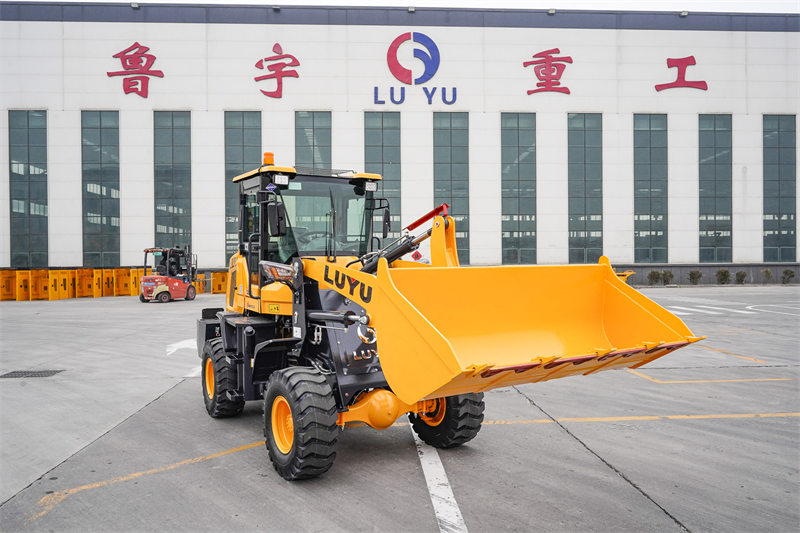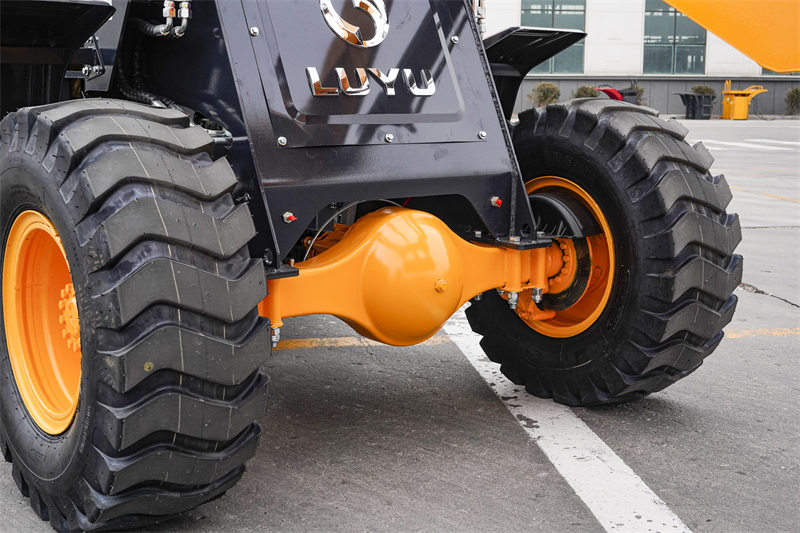How to choose the tire of wheel loader
2024-02-05
When we buy a wheel loader, the first thing we need to know is that the tire of the loader is very important to the loader, and using the right tire can extend the service life of the tire and reduce operating costs. When we use improper tires may have some bad effects on the loader. Lu Yu Machinery is a construction machinery manufacturer with 20 years of experience, with rich experience in wheel loader manufacturing, can give you more professional advice on wheel loader tires. Let's take a look at what effects improper tires can have on wheel loaders.

1. Reduced traction and stability: tires that are not suitable for the working environment or ground conditions may not provide enough traction, resulting in the loader not being able to grip the ground firmly when operating. This reduces the stability of its ride and operation, increasing the risk of sideslip and loss of control.
2. Impaired handling: Incorrect tire selection may lead to decreased handling. For example, when using hard tires to operate on soft ground, the tires can not fit well to the ground, resulting in difficult handling and may even cause steering loss.
3. Reduced durability: The use of unsuitable tires may lead to faster tire wear and damage. If the tire is not adapted to the requirements of the working environment, such as using ordinary road tires to operate on rough construction sites, the tire may be subjected to additional impact and wear, shortening its life.
4. Increased energy consumption: Improper use of tires may increase the energy consumption of the loader. For example, driving on flat roads with high-resistance tires results in more energy consumption and lower fuel efficiency.
5. Increased safety risks: The wrong tire choice can increase accidents and safety risks. Tires that do not provide adequate traction or stability can cause the loader to lose control during operation. Rollover or landslide, posing a threat to the safety of the operator and those around it.

Different types of tires can be selected according to the work scenario and specific needs. Each type of tire has its own unique characteristics and scope of application, and the most suitable tire choice can be determined based on the working environment, ground conditions and material type.
1. Soft tires: Soft tires are made of rubber and filled with air. They have good elasticity and cushioning effect, which can provide better driving comfort and handling. Soft tyres are adaptable, able to adapt to changes in different surfaces and are able to provide stability and traction on uneven surfaces. Soft tires are suitable for a variety of sites, such as construction sites, storage yards, logistics centers and general road transportation. They are suitable for operation on relatively flat ground and can provide good performance on different surfaces.
2. Solid tire: Solid tire is made of rubber or polyurethane material and has no inflatable cavity. They have excellent wear and damage resistance and are not prone to air leakage or puncturing. Solid tires can withstand heavy loads and high pressures, but also suitable for use in harsh working environments. Solid tires are commonly found in places that need to work in harsh conditions such as landfills, mining sites or construction sites. They are suitable for handling heavy materials and operating in environments where higher durability and reliability are required.
3. Wire tire: Wire tire is made of steel wire, has very high durability and load capacity, they can withstand heavy loads and high pressure, and has a good grip on hard ground or rock surface. Wire tires are generally more wear-resistant than other types of tires and can provide long-term stable performance in harsh conditions. Steel wire tires are mainly used in mining, metallurgy and other industries that need to handle heavy materials. They are suitable for operation on rocks, hard ground or uneven surfaces.
4. Track tires: Track tires are specially designed for running on railway tracks. They have a special tyre profile and rubber combination to suit the shape and requirements of the railway track. The track tire has good stability and grip to ensure that the loader can provide safe and efficient transportation when traveling in the railway system. Track tires are mainly used in cargo handling operations in ports and logistics centers, as well as places where loading and transportation needs to be carried out in the railway system. They are suitable for operation on railway tracks and are capable of meeting the requirements of the railway system.

In addition, the different tire patterns will also have an impact on the applicable work scene, which types of wheel loader patterns are there?
1. Flat pattern: Flat pattern is one of the most common tire pattern types. They have a smooth surface and are suitable for general road driving and light work scenarios. Flat patterns provide good traction and stability, suitable for operation on flat surfaces.
2. Mixed pattern: Mixed pattern is a combination of flat pattern and groove pattern design. They feature different-sized and spaced grooves on the tire surface to provide better traction and drainage performance. The mixed pattern is suitable for a variety of work environments, including construction sites and storage yards.
3. Rectangular pattern: The rectangular pattern is a raised pattern design with a rectangular shape, which forms a blocky pattern on the tire surface to provide a large ground area and traction. The rectangular pattern is suitable for more rugged terrain and demanding traction scenarios, such as mining and agriculture.
4. Deep pattern: Deep pattern has deep grooves and patterns to increase the contact area and traction between the tire and the ground, which is suitable for harsh ground conditions, such as slippery muddy ground, snow and ice road surface or soft sand. The deep pattern provides better traction and self-cleaning ability.
5. Nail pattern: Nail pattern is a design with metal nails on the tire surface. These nails increase the friction between the tire and the ground and provide additional traction, especially for working in snow, ice or extremely cold areas.

Different tire pattern types can be determined according to the specific work scenario, ground conditions and needs. Different pattern types of tires can provide different traction, stability and self-cleaning capabilities to meet the requirements of different working environments.
The above is some little knowledge about loader tires, I hope this article can help you.



